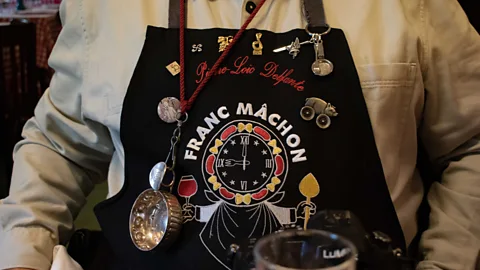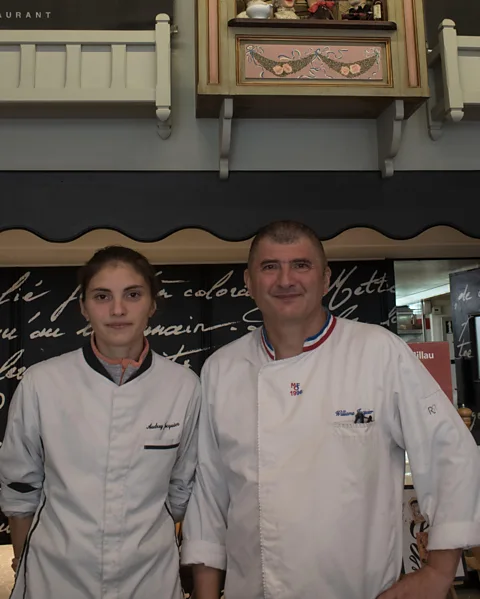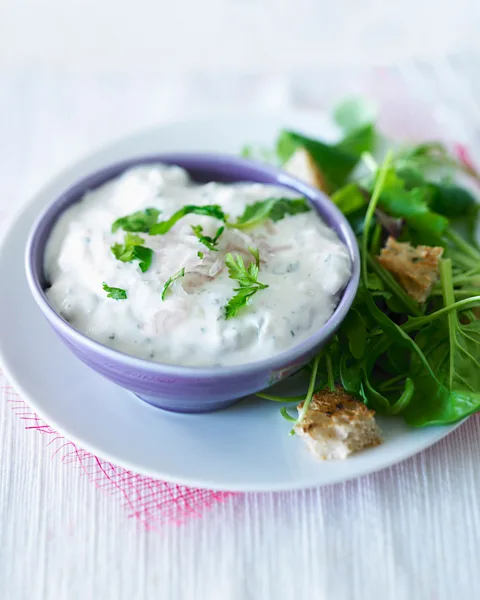Features correspondent
 Anna Richards
Anna RichardsWhile France is renowned for its pains au chocolat and croissants, Lyon has a long-standing tradition of tucking into wine and offal at breakfast.
Among the high-rise apartment blocks of Vaise, one of Lyon’s newer quartiers (districts), I stepped into a little restaurant where time seemed to have stood still for 100 years. From the outside, Les 4G, a Lyonnais bouchon (traditional restaurant), looked much like the nondescript cafe-cum-tobacco shops that can be found in most small French towns, but inside the decor was as warm and inviting as a country pub. The red gingham tablecloths matched the chequered napkins, which were neatly stored in shelving units along the wall with brass plaques indicating each owner’s name – regular clientele who had their own napkin stored for them.
As I sat down, sandwiched between jolly retirees Pierre-Loïc Delfante and Jean Paul Pillon, I realised that I was the youngest in the group by more than 30 years. The cheese delivery had just arrived, and the chef was unpacking brown paper bags containing soft balls of cervelle de canut, an unappetising name that translates as “silk workers’ brain” but looks like cottage cheese. Delfante filled my glass with a crisp white wine from Beaujolais. It was 9:00 in the morning.
I’ve always found French petit déjeuner (breakfast) insubstantial, but that wasn’t the first thing that came to mind as I scanned the menu on the blackboard. Gone were the tartines and croissants, replaced instead by a list that read like a biology textbook: rognons de veau (calf’s kidney), tablier de sapeur (fried, breaded tripe), tête de veau (calf’s head). This was mâchon, a long-standing Lyonnais breakfast tradition where no part of the animal goes to waste.
 Philippe Desmazes/Getty Images
Philippe Desmazes/Getty ImagesAs dish after dish arrived, I tried to convince myself that the fried tripe slices could be mushrooms, but the boiled calf’s head encased in grey gelatine didn’t resemble anything I’d eaten before. Oddly, the calf’s head tasted pretty good, a little like warm, soft pork scratchings, though I struggled to look at it.
How to try mâchon
While a traditional mâchon should be served at 09:00, many Lyon bouchons now serve mâchon as late as 10.30. In the past, mâchon was served exclusively on weekdays, but it’s now more common to see restaurants serving up their boozy breakfasts on Fridays, Saturdays and Sundays. Generally, it’s best to book in advance.
Try mâchon at Le Vivarais (Saturdays; don’t miss Audrey Jacquier’s pâté en croûte), La Meunière (Tuesday-Saturday), and Les 4G (Monday-Friday). Prior reservations are essential at each.
“Pig is a vegetable which goes with everything!” said Pillon, his eyes twinkling as he offered me a slice of pâté en croûte.
We moved onto a red wine from Beaujolais, and, after a couple of sips, my glass was promptly topped up again. It was like an antiquated version of a prosecco-and-avocado toast millennial bottomless brunch.
Lyon’s curious tradition of tucking into wine and offal at breakfast started several centuries ago.
Between the mid-16th and 19th Centuries, the city’s silk industry was among the most important in Europe. The canuts (silk workers) would often work for up to 12 hours a day to meet demand as silks became increasingly popular with French nobility. Traboules, covered passageways that labyrinth across Lyon and characterise the city’s architecture, were used for transporting the precious material between buildings. Although the oldest of Lyon’s 400-odd traboules are thought to date from as early as the 4th Century CE, many were built in Croix-Rousse (the city’s silk weaving quartier) during the silk industry boom. And with canuts often starting work in the small hours of the morning, by 09:00 they needed more sustenance than a pain au chocolat or croissant.
Working with what was on their doorstep, Lyonnais restaurants served up offcuts of meat, mostly cow or pig, that were farmed in the hills just outside the city. With the winegrowing region of Beaujolais just 32km north of Lyon, the offal was typically washed down with copious amounts of wine. Mâchon (which means “chew”) was also a moment for silk weavers, merchants and businessmen to come together to break bread and discuss business affairs, sign contracts and make deals. This mixing of classes was seen as a societal leveller – although perhaps this is apocryphal since many believe that the “silk workers’ brains” cheese typically served as a “dessert” was named as a dig at the supposed lack of intelligence of the canuts. Either way, many businesses in Lyon still choose to conduct meetings over a mâchon today.
 Anna Richards
Anna RichardsMy breakfast that morning was with members of the Francs-Mâchons, a local society founded in 1964 that comes together six times a year to feast on innards for breakfast. Club president and mâchon die-hard Delfante told me that he had enjoyed no less than nine mâchons in the last 10 days. He was sporting a large napkin fastened around his neck with a chain and a matching apron, both designed especially for the Francs-Mâchons. Embroidered on each was a clock face set to 9:00, the time when mâchon begins, encircled by little sausages and what looked like farfalle pasta but was, in fact, a delicately sewn representation of another machon specialty: paquets de couennes (boiled pig skin folded like a bow tie and fastened with string). Hanging around his neck was a beaten metal wine-tasting cup.
To be a Francs-Mâchon, you must be male, over 30 and be recommended by two existing members. The group never numbers more than 40, so aspiring Francs-Mâchons must wait for a member to leave… or die. Delfante told me he was a member for almost 30 years before being elected their president.
A women’s equivalent, a club called the Mâchon des filles was set up by Lyonnais locals 17 years ago. They’re much less regimented, and their members, who range in age from 18 to 80, include Americans, British and Swiss women, as well as locals.
“I’ve known about the mâchon tradition my whole life,” said their president and one of the founding members, Valérie Girod. “My father was a plasterer and painter, and in the 1960s he’d regularly start his workday at 05:00 or 06:00 and break a few hours later for a mâchon.”
“Most of the Francs-Mâchons weren’t happy when we set up a women’s society,” Girod added. “They felt that women were meant to be serving the food, not eating it. There are a few sticklers for tradition that still feel that way, but most of them are now delighted that there’s a women’s equivalent.”
 Anna Richards
Anna Richards“The girls can easily sink two bottles of Beaujolais per person,” Williams Jacquier later told me, admiringly. We’d met at his upmarket restaurant, Le Vivarais, on Lyon’s Presqu’île, which he runs with his daughter Audrey. Their Saturday morning mâchon is particularly popular.
Williams and Audrey opened their restaurant 13 years ago. Audrey was barely 19 at the time and she has reinvented many of the traditional mâchon dishes, choosing to include more vegetables and use less fat than most traditional bouchons.
Her pâté en croûte, containing nine different types of meat delicately moulded in a baking tin longer than my arm, earned her fourth place in the 2013 World Pâté en Croûte Championships. For the second time in a week, I found myself with a glass of Beaujolais in my hand at 09:00, as father and daughter chimed in over each other, listing the different meats included: sweetbread, foie gras, pork throat. None of it had travelled further than 60km. The slice that I was offered was mosaic-like in various shades of pink, the pastry as flaky as a croissant.
“Families, stag dos, business meetings,” Williams said, listing their clientele. “All ages. Students bringing their partners on dates. As it was in the past, mâchon is a great leveller. It’s undergoing a renewed popularity; people are keen to reconnect with the past and revive old traditions.”
“Mâchon is an excuse for people to sit back, relax, and share moments over a good meal,” added Audrey. “It’s as simple as that.”
Williams and Audrey don’t believe that mâchon is at risk of disappearing, even with more people choosing to adopt a plant-based diet.
“We’ve adapted to the times,” said Williams. “People don’t eat as much rich, fatty food as they did at the turn of the 20th Century, so we’ll add a little less cream here, a little less butter there.” They try to keep the farm-to-fork circuit as short as possible too, using vegetables, meat and wine from the Lyon area.
 Image Professionals GmbH/Alamy
Image Professionals GmbH/AlamyBack at Les 4G with the Francs-Mâchons, I pushed the remains of the now-cold tripe around my plate. I felt I’d made a valiant attempt, and I moved onto my cervelle de canut, served in an ice cream bowl and mixed with vinegar and spring onions, with gusto. Compared with the dishes licked clean by my companions though, my effort was paltry.
Delfante and Pillon adjourned to the adjacent table. As is tradition, it was time to conduct business, although business this morning concerned the happy task of mapping out in which order they’ll visit the various bouchons participating in the following week’s Mâchon Week, an increasingly popular annual event where Lyon restaurants compete to put on the best spread. Restaurants that wouldn’t typically serve up mâchon join in too, and after five days of mâchons, wine tastings and cheese samplings, the Francs-Mâchons award certificates to the establishments that have that cook up the best mâchon.
It was more than three hours later when I finally emerged from the scarlet time warp back into the mass of 21st-Century apartment blocks. I pedalled past a burger joint and multistorey office buildings, the air thick with exhaust fumes. People dashed in and out of buildings with sandwiches in their hands, glancing anxiously at their watches. I moved slowly with a full belly and my head pleasantly fuzzy with wine.
“We often trivialise mealtimes these days and eat badly,” said Girod. “Mâchon makes us take a proper pause. We’ve spent all day over mâchon before. More than that though, we’re bringing custom to traditional restaurants and we’re stopping typical dishes from disappearing from view.”
From the warm welcome I’d received from the men at Les 4G and Girod’s insistence that I join the next women’s mâchon, it seems that this French breakfast tradition is just as great a leveller as it ever was.
Culinary Roots is a series from BBC Travel connecting to the rare and local foods woven into a place’s heritage.
